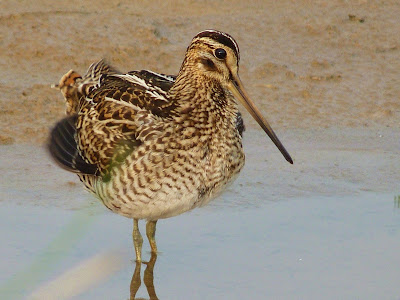Hi all,
Last Sunday, I accompanied Mr. Trải and Mr. Trường of Birdlife to a coastal commune at the very south of Nam Dinh province, where we took a boat to Cồn Thông, a sea dune at the mouth of the River Đáy. In the cold and rain, the first creature we met was this poor little guy hung on a blind net which is about 100-meter long.

I was only given a minute to take the above photo before Mr. Truong started to gently remove the bird from the net. He must have been trying very hard to escape. This much of nilon threat was tangled on his left wing.
Ha Hoang
Birdlife staff
PS. Just want to share the list of birds that we saw during the birding trip to Red River Delta. Our team consisted of Mr. Trai, Mr. Truong and me. In Xuan Thuy, we were joined by David - a very helpful volunteer.
In Thai Thuy, Thai Binh (on Jan 12, 2012)
Common Kingfisher
White-throated Kingfisher
Spotted Dove
Spotted Redshank (<10)
Common Redshank
Marsh Sandpiper
Common Greenshank
Green Sandpiper
Pacific Golden Plover (25)
Kentish Plover (20)
Black-headed Gull (150)
Saunders's Gull (17)
Gull-billed Tern (1)
Little Tern
Little Egret
Chinese Pond Heron
Long-tailed Shrike
Black Drongo
In Xuan Thuy National Park (on Jan 13, 2012)
Eurasian Wigeon (500)
Spot-billed Duck (350)
Northern Shoveler (250)
Northern Pintail (150)
Garganey (300)
Common Teal (250)
Common Kingfisher
White-throated Kingfisher
Pied Kingfisher
Greater Coucal
Spotted Dove
Common Moorhen
Black-tailed Godwit (50)
Eurasian Curlew (15)
Eastern Curlew (13)
Common Redshank (5)
Marsh Sandpiper (25)
Common Greenshank (45)
Common Sandpiper
Grey-tailed Tattler (15)
Great Knot (<20)
Sanderling (130)
Dunlin (650)
Grey Plover (250)
Kentish Plover (850)
Herring Gull (22)
Black-headed Gull (450)
Black-shouldered Kite (1)
Eurasian Marsh Harrier (1)
Peregrine Falcon (1)
Little Egret
Grey Heron
Great Egret
Cattle Egret
Chinese Pond Heron
Black-faced Spoonbill (35)
Long-tailed Shrike
Black Drongo
In Nghia Hung, Nam Dinh (on Jan 14, 2012)
Common Kingfisher
White-throated Kingfisher
Bar-tailed Godwit (5 birds)
Eastern Curlew (5)
Common Redshank
Red-necked Stint (200)
Dunlin (150)
Spoon-billed Sandpiper (1)
Grey Plover (55)
Kentish Plover (300)
Herring Gull (15)
Black-headed Gull (150)
Saunders's Gull (5)
Little Egret
Long-tailed Shrike
Black Drongo
 Those pics of Bluethroat could have been good... Unfortunately, in the morning, I tested the highest ISO settings of my camera (which is a "bridge", not a DSLR) and I forgot... to change them before going in the field. Those 2 photos suffering a common malady, called "High ISO noise".
Those pics of Bluethroat could have been good... Unfortunately, in the morning, I tested the highest ISO settings of my camera (which is a "bridge", not a DSLR) and I forgot... to change them before going in the field. Those 2 photos suffering a common malady, called "High ISO noise".




































